Event
From Silos to Synergy: Key Communication Integrations at Roper St. Francis
Register >>TABLE OF CONTENTS
We could try the approach from “Scrubs” and dump kittens on patients—but there are probably better ways to treat a patient with heart failure and sadness.
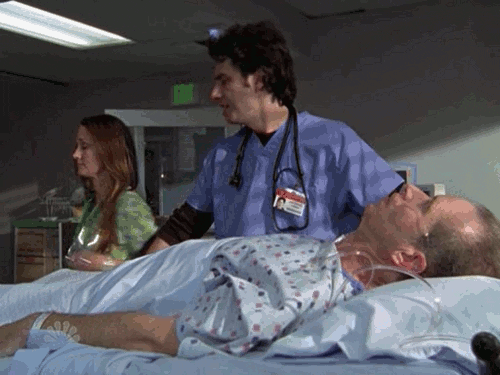
As we discuss implementing good bedside manner, let’s take a look at the history of its practice and implications for the 21st century, and how healthcare communication software can play a role.

One definition of bedside manner is “the way a health care professional handles a patient in a doctor-patient relationship.”2 Other medical dictionaries define it as “the attitude and conduct of a physician in the presence of a patient”3 or “behavior of a health care professional toward a patient, client, or resident of a facility.”4
Fast forward to 18th century Europe, and Thomas Percival influenced a codification of “Medical Ethics” and guidelines for best practices in medicine for pharmacists, surgeons, and prescriptive physicians.5 In the 19th century, medical leaders like Victor Vaughn and William Olser agreed there should be a standard focus on evidence-based medicine, and this approach placed emphasis on physiology over social and psychological disciplines.6
To deal with medical and ethical controversies in the US, the American Medical Association (AMA) was founded in 1847. The intention behind AMA’s founding was to build more accountability and define best medical practices. By the 20th century, a unified directory was created for licensed physicians. It included specific criteria with an emphasis on physical needs over emotional and psychological ones. In the 21st century, the AMA also displayed willingness to acknowledge past flawed practices when its leadership apologized for over a century of policies that excluded African Americans.7
Medical organizations in the 21st century need to take steps to address current healthcare disparities, which includes taking a more holistic approach to practicing medicine. Bedside manners today can include a hybrid of face-to-face, digital interactions among physicians, patients, and their families. With 97% of patients carrying mobile devices, this provides an opportunity across socio-economic barriers to leverage technology that improves health equity gaps.
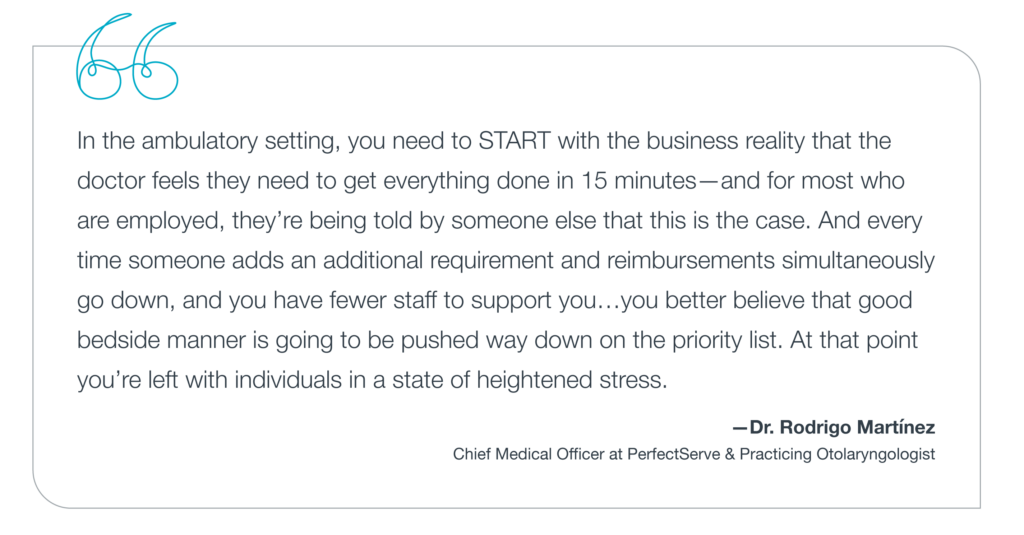
In a clinical landscape where resident burnout and primary care burnout8 are increasing, patient demands and organizational policies can sometimes shackle physicians and nurses. While speed to care is important, especially in more time-sensitive scenarios, we shouldn’t underestimate the importance of the minutes spent talking with patients to thoroughly understand their concerns—no matter how serious.
Holistic health techniques, which often place a strong emphasis on proper bedside manner, may not always align with predetermined financial incentives that necessitate efficiency above all else. Clinicians also have to spend about 50% of their time living in the EHR before and after patient visits. As physicians rigorously document their interactions according to insurance guidelines, the tedious and repetitive nature of this kind of administrative work can make them feel dissatisfied with their profession.9
With these constraints in mind, polite bedside manners might be replaced with a colder, more “strictly business” approach, similar to the protagonist physician’s character in the TV series, “House.” Do physicians get “bonus points” if they exhibit a more positive bedside manner?

For example, if “solve it in 10 minutes” becomes the standard of measurement for patient-provider interactions, practitioners will likely find it harder to provide authentic and attentive care. Despite their best intentions, this prescriptive approach can even lead to physicians becoming disillusioned and less in tune with their patient’s health. They may view patients as part of a more transactional process, using medical jargon that patients don’t understand.10
One psychologist coined the phrase “self-protective empathy lethargy” (or “SPEL”), which impacts caregivers when there is an imbalance between empathy and the extent to which they feel they have enough control to do something about a patient’s concerns.11 SPEL kicks in when providers are pushed to their limits. With SPEL, staff shortages, and changing patient expectations, what can healthcare practitioners and leaders focus on to bring about more positive patient outcomes?
Part of the answer? Kindness in bedside manner. Based on research and practicing psychiatrists, we know that kindness reduces other risks such as heart disease, diabetes, stroke, mental illness, infection, cancer, autoimmune disorders, premature death, and other comorbidities.12 When used effectively, we also know that physician-patient communication leads to better physiologic outcomes. A simple smile or sitting at eye level with a patient can go a long way, even if the visit is short.
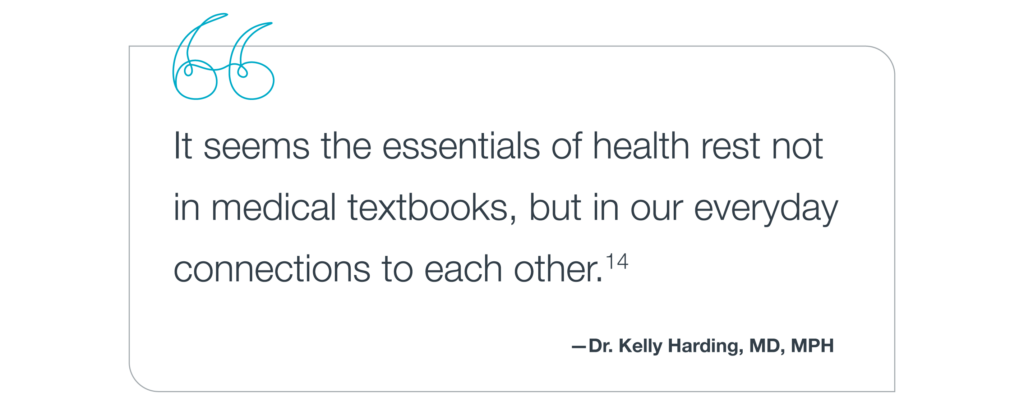
Technology and transactional encounters in healthcare may have created an unkind atmosphere. Time spent with patients may get reduced to meet financial goals. This focus inadvertently affects patient outcomes, especially when emotional connections are needed between a physician, practitioner, and patient. When triaging in an emergency, disaster, or epidemic, it places additional strain on a physician’s time with patients.
Is there a way to make technology benefit practitioners and their patients? With the right understanding, technology workflows can be applied in a way that clinicians get time back in their day while still achieving positive health outcomes.
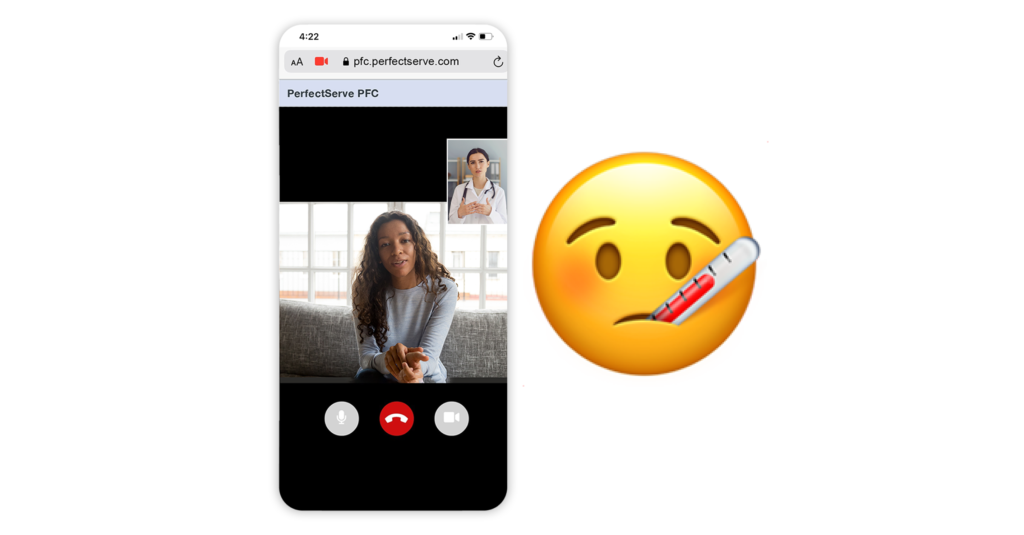
Can technology inform physicians about what they’re getting into ahead of time? Telehealth has moved bedside manner to the “webside,”15 making possible video consultations that reveal body language, tone of voice, and other visual and auditory cues. With virtual visits and mobile devices for taking notes, medical professionals can more easily remember what to discuss at their next appointment, reducing delays in care and diagnosis.
Patient engagement and secure text messaging tools also provide a conduit for genuine care and patient follow-ups. A few examples include patient surveys, wellness checks, and friendly reminders about in-person or virtual visits. If patients are aware of what to expect, it can reduce the stress typically associated with a clinic visit. Read more about PerfectServe Patient Engagement here.
Checking in on patients post-surgery or after hours via video, in the comfort of their home, can also be a major net positive. It alleviates the need for patients to find transportation, schedule a babysitter, or worry about wound dehiscence. The video background for the practitioner can even be fashioned as a nice, warm home setting, establishing a friendlier environment for the patient.
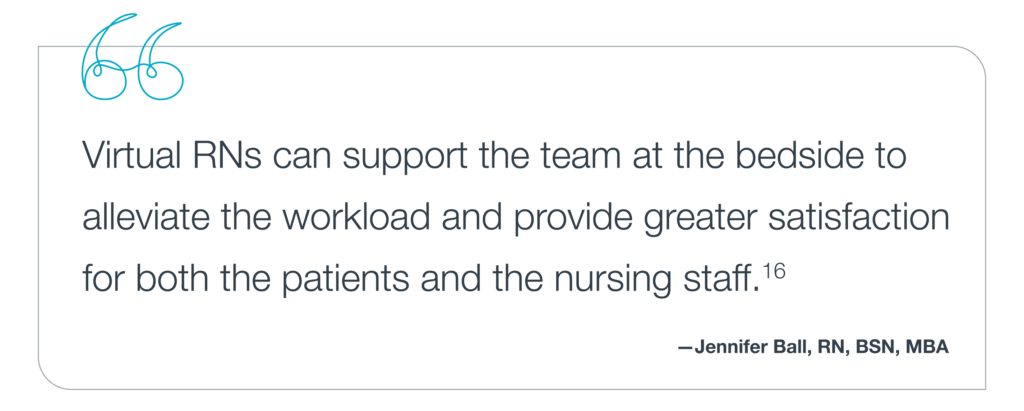
Jennifer Ball, a nurse and director of virtual care, advises that using technology at the bedside requires staff buy-in, along with flexibility and willingness to try new things.17 Many tasks that don’t require the nurse at the bedside can be completed by a virtual nurse, freeing up time for in-person nursing staff to focus on quality patient engagement. With this virtual assistance, patients can quickly receive information and assistance with the push of a button.18
When digital tools are deployed throughout your healthcare organization, it’s important for nurses and physicians to focus on creating authentic connections to ensure patients feel more comfortable,19 whether at home, in a community center, or at the hospital.
One study found that virtual physicians can be as persuasive as their in-person counterparts, and patients readily accept their advice and care plan adherence—as long as their bedside manner is positive. Participants were presented with different physician appearances based on an “eeriness” factor. They also presented two characters to patients: one having a poor bedside manner (joking about their condition, trying to end the visit early, and other rude behaviors), and the other eliciting warmth and kindness in their bedside manner.
Whether eerie-looking (called the “uncanny valley” effect) or not, “a physician with good bedside manner prompted greater systemic processing in HSM, which increased adherence intention and exercise change.”20 HSM stands for the heuristic-systematic model, which determines how people process information and understand and evaluate its content,21 along with the trustworthiness of the source.
The expressions a clinician uses during an in-person visit could be supplemented by digital facial expressions—also known as emoji.

Expressive emoji are a visual way to communicate quickly with children, non-English speaking patients, and those who are hard of hearing. 90% of emoji users agree that the icons make it easier to express themselves.22 Across 21 medical specialties, the “thumbs up” emoji is used the most, and internal medicine shows the highest use of all emoji among practitioners.23
Emoji usage among medical staff and patients might also be a way to improve kindness and empathy in a clinician’s digital bedside manner. These images tend to inject a bit of warmth and emotion into an otherwise cold medium (text on a screen), so any approach that humanizes communication and conveys that the person on the other side is reading, reacting, and chatting like a “normal” person can be tremendously helpful.
For more research on emoji use in medical settings, download our report, “The Rise of Emoji in Healthcare Communication.”
Comments from Medical Professionals
Not long ago, many medical school curriculums did not place a huge emphasis on teaching proper bedside manner. A few comments regarding this topic:
“When I was in med school, nope, we did not have any courses in bedside manner. My understanding is that some med schools now have ‘doctoring’ courses as part of their curriculum, which formally address the acculturation aspect of becoming a doc, presumably including how to behave and interact with patients and families.”24 – Matt
“During your clinical rotations, you will see how many different doctors address patients. Honestly, I think it’s a myriad of factors that create good bedside manners and most are common sense. One, try to treat everyone with respect. Two, remember, ‘I’m not the sick/injured one in this dynamic.’ Doctors see people at their worst, frequently, and it is our job to make them feel better. 3) It’s ok to have a personality and be a doctor. It’s amazing how just a little small talk can ease a patient’s anxiety.”25 – Dave
“In nursing school, we are taught that, despite knowing the answer to everything, if your bedside manner isn’t the best, you aren’t doing it right.”26 – Jamie
Medical schools are now taking steps to emphasize bedside manner by interweaving teachings about its principles with clinical coursework. A few schools even teach telehealth medicine, such as how to use electronic stethoscopes and maintain eye contact with patients.24
Whether digital or in person, education programs now include lessons about empathy, communication skills, mannerisms, humor, and real-life mentorships.25 One program at Vanderbilt University School of Medicine focused on how the lighting in a room affects patients and emphasized knocking on the door and introducing oneself to the patient and family members with a handshake.26
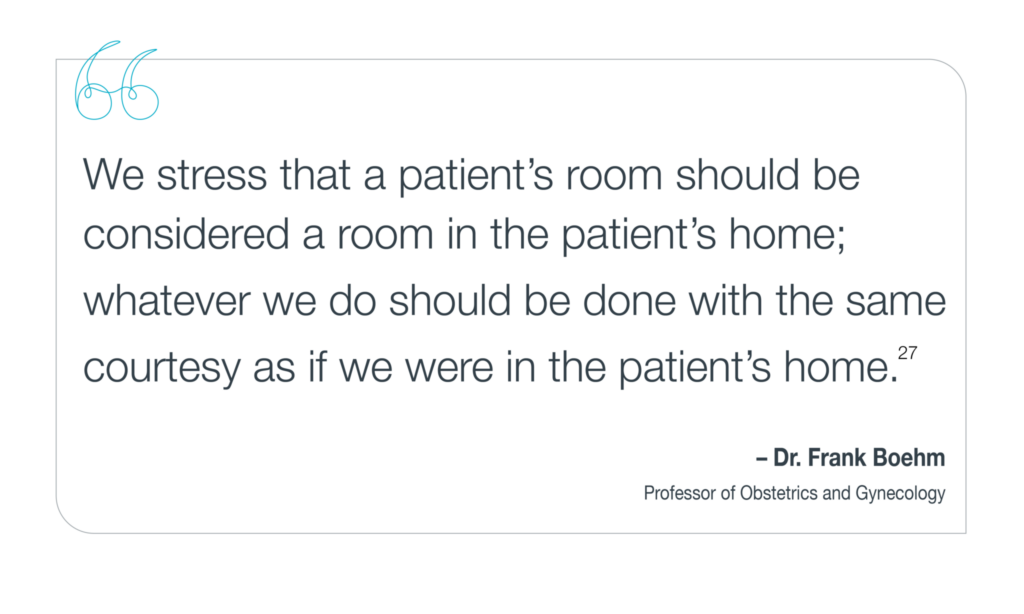
The “Stanford 25” approach teaches medical students about the concept of “observing, examining, and connecting with patients.”28 They emphasize humility at the bedside, and propose four attributes: 1) unpretentious openness, 2) avoidance of arrogance, 3) honest self-disclosure, and 4) modulation of self-interest, along with acculturation and panel discussions with patients.29 Stanford Medicine is paving the way to establish a healthier bedside medicine culture for medical faculty members and institutions, and you can learn more in their “Creating a Bedside Medicine Culture” here.
The University of Colorado School of Medicine places a focus on learning patient bedside manner during the third year of medical studies. Students spend 10 months serving in outpatient settings related to their specialty.30 They experience a realistic picture of healthcare and are better equipped to deal with complicated people, conflicts, teamwork, and quality improvement.
Here is a list* of medical schools that emphasize bedside manner, or a variation of patient-centered care, as part of their curriculum:
*Note: This list is not exhaustive. If you know a medical or nursing school that includes bedside manner in their curriculum, please email the name of the school to Matt Kothe and we’ll update the list. Thanks in advance for your contribution!
In the world of medicine, there are probably more uncertainties than there are stone-cold, unimpeachable truths. We know a lot, but we don’t know everything.
One thing that cannot be argued, however, is that showing kindness and empathy will lead to better patient experiences, better outcomes, and a more positive culture for medical professionals who too frequently feel like they’re checking boxes to meet financial goals rather than providing the best, most authentic care for their patients. Proper bedside manner isn’t the only requirement for being a good doctor, but it will always make a difference.
Read how PerfectServe has helped healthcare organizations across the U.S. accelerate speed to care with better provider scheduling, efficient care team collaboration, enhanced call routing, and secure patient text and video messaging solutions.
Make sure to follow PerfectServe on LinkedIn, YouTube, TikTok, Twitter, and Facebook.
Sources
1 Physician behavior and bedside manners: the influence of William Osler and The Johns Hopkins School of Medicine, NCBI, Barry D Silverman, MD: https://www.ncbi.nlm.nih.gov/pmc/articles/PMC3246857/
2 Bedside Manner, Blanchard Valley Health System, Nancy Proctor: https://www.bvhealthsystem.org/expert-health-articles/bedside-manner
3 Bedside manner, The American Heritage® Medical Dictionary: https://medical-dictionary.thefreedictionary.com/bedside+manner
4 Bedside manner, Medical Dictionary for the Health Professions and Nursing: https://medical-dictionary.thefreedictionary.com/bedside+manner
5 Thomas Percival, Discussing the foundation of Medical Ethics, NCBI, Patuzzo Sara, Goracci Giada, Ciliberti Rosagemma: https://www.ncbi.nlm.nih.gov/pmc/articles/PMC6502118/
6 Physician behavior and bedside manners: the influence of William Osler and The Johns Hopkins School of Medicine, NCBI, Barry D Silverman, MD: https://www.ncbi.nlm.nih.gov/pmc/articles/PMC3246857/
7 AMA History, American Medical Association: https://www.ama-assn.org/about/ama-history/ama-history
8 Charted: The pandemic’s ‘alarming toll’ on primary care physicians, Advisory Board: https://www.advisory.com/daily-briefing/2022/11/28/primary-care-burnout
9 Importance Of Communication In Medicine: Views On Bedside Rounding And Readmissions, Yale Medicine Thesis Digital Library, Allen F. Shih: https://elischolar.library.yale.edu/ymtdl/3448
10 Developing Good Bedside Manner: 9 Tips for Doctors, St. George’s University: https://www.sgu.edu/blog/medical/how-to-develop-good-bedside-manner/
11 The Kindness Cure, New Harbinger Publications, Tara Cousineau, 2018: p. 10-11.
12 The Rabbit Effect: Live Longer, Happier, and Healthier with the Groundbreaking Science of Kindness, Atria Books, Kelli Harding, 2019: p. 193.
13 Importance Of Communication In Medicine: Views On Bedside Rounding And Readmissions, Yale Medicine Thesis Digital Library, Allen F. Shih: https://elischolar.library.yale.edu/ymtdl/3448
14 The Rabbit Effect: Live Longer, Happier, and Healthier with the Groundbreaking Science of Kindness, Atria Books, Kelli Harding, 2019: p. 193.
15 From Bedside to Webside: Future Doctors Learn How to Practice Remotely, Association of American Medical Colleges: https://www.aamc.org/news-insights/bedside-webside-future-doctors-learn-how-practice-remotely
16, 16, 18 Virtual Nursing: What is it?, American Nurses Association Innovation, Jennifer Ball: https://www.nursingworld.org/practice-policy/innovation/blog/virtual-nursing-what-is-it/
19 Why It Is Important To Have Good Bedside Manner, Concorde Career Colleges: https://www.concorde.edu/blog/why-it-important-have-good-bedside-manner
20, 21 Creepy, but Persuasive: In a Virtual Consultation, Physician Bedside Manner, Rather than the Uncanny Valley, Predicts Adherence, Frontiers In Virtual Reality, Zhengyan Dai , Karl F. MacDorman: 10.3389/frvir.2021.739038
22, 23 The Rise of Emoji in Healthcare Communication, PerfectServe: https://www.perfectserve.com/the-rise-of-emoji-in-healthcare-communication/
24 (2018). From Bedside to Webside:Future Doctors Learn How to Practice Remotely. Association of American Medical Colleges. https://www.aamc.org/news-insights/bedside-webside-future-doctors-learn-how-practice-remotely
25 Swanson, D. (2018, January 10). How Medical and Nursing Schools are Teaching Bedside Manner Today. The Daily Nurse. https://dailynurse.com/medical-nursing-schools-teaching-bedside-manner-today/
26, 27 Teaching Bedside Manners to Medical Students, Journal of the Association of American Medical Colleges, Frank Boehm: https://journals.lww.com/academicmedicine/fulltext/2008/06000/teaching_bedside_manners_to_medical_students.5.aspx
28 About Stanford Medicine 25, Stanford Medicine: https://stanfordmedicine25.stanford.edu/about.html
29 Teaching Humility at the Bedside, Stanford Medicine, Damiana Andonova: https://stanfordmedicine25.stanford.edu/blog/archive/2014/Teaching-Humility-at-the-Bedside.html
30 Colo. Medical Students Taught Proper Bedside Manner Along with Medicine, EMS World, Jakob Rodgers: https://www.hmpgloballearningnetwork.com/site/emsworld/news/12206215/colo-medical-students-taught-proper-bedside-manner-along-with-medicine